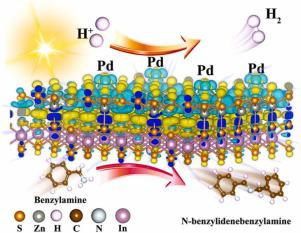Nano Energy ( IF 16.8 ) Pub Date : 2022-02-11 , DOI: 10.1016/j.nanoen.2022.107045 Penglei Wang 1 , Shiying Fan 1 , Xinyong Li 1 , Jing Wang 1 , Zhiyuan Liu 1 , Zhaodong Niu 1 , Moses O. Tadé 2 , Shaomin Liu 2

|
Photocatalytic hydrogen production coupled with selective oxidation of organic substances is of significance and remains a grand challenge because of unsatisfied photocatalytic activity and unclear mechanism. Herein, we first design and synthesize atomically dispersed Pd on ZnIn2S4 (PdSA-ZIS) for simultaneously photocatalytic hydrogen production and oxidation of benzylamine. Based on systematic characterization with a combination of theoretical simulations, light irradiation-kelvin probe force microscopy (KPFM) and time-resolved photoluminescence spectrum etc, we demonstrate that Pd single atoms can modulate charge polarization as well as the active sites of ZnIn2S4 to promote spatial charge separation and decrease the energy barriers of reaction. The electrons are enriched around Pd single atoms-ZnS layer with lowest energy barriers of H2 production, while more holes are accumulated on InS2 layer for dehydrogenation of benzylamine. This enables PdSA-ZIS to exhibit remarkable photocatalytic performance for the co-production of N-benzylidenebenzylamine (10.2 mmol g−1 h−1) with selectivity of 100% and H2 (11.1 mmol g−1 h−1) under visible irradiation. Furthermore, by means of controlled experiments, theoretical simulations and in situ electron spin resonance (ESR) spectroscopy, a synergetic photocatalytic redox mechanism on the Pd single atom-ZIS interface for dehydrogenation and coupling of benzylamine and H2 production has been investigated in detail.
中文翻译:

单钯原子协同调控电荷极化和活性位点同时光催化制氢和氧化苄胺
光催化制氢与有机物质的选择性氧化相结合具有重要意义,但由于光催化活性不令人满意且机理尚不清楚,因此仍然是一个巨大的挑战。在此,我们首先设计并合成了原子分散在 ZnIn 2 S 4上的 Pd (PdSA-ZIS),用于同时光催化制氢和氧化苄胺。基于结合理论模拟、光辐照-开尔文探针力显微镜(KPFM)和时间分辨光致发光光谱等的系统表征,我们证明了Pd单原子可以调节电荷极化以及ZnIn 2 S 4的活性位点。促进空间电荷分离并降低反应的能垒。电子富集在Pd单原子-ZnS层周围,产生H 2的能垒最低,而更多的空穴聚集在InS 2层上,用于苄胺的脱氢。这使得 PdSA-ZIS 表现出卓越的光催化性能,可用于联产 N-亚苄基苄胺 (10.2 mmol g -1 h -1 ),选择性为 100% 和 H 2 (11.1 mmol g -1 h -1) 在可见光照射下。此外,通过受控实验、理论模拟和原位电子自旋共振 (ESR) 光谱,详细研究了 Pd 单原子-ZIS 界面上的协同光催化氧化还原机制,用于苄胺和 H 2生产的脱氢和偶联。


















































 京公网安备 11010802027423号
京公网安备 11010802027423号